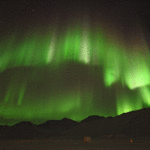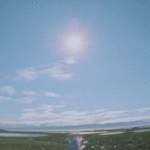I live in a city where for almost six months out of every year the weather could literally kill me.
The darkness of winter nights here in Alberta stretch from 3pm one afternoon to 9am the next morning. The mercury falls to 20 below as often as not, colder than that if the wind begins to blow. On those days, Fahrenheit and Celsius agree on the temperature, shake hands, and hibernate beneath the aurorae. The rest of us gather around our fireplaces, under wool-knit point blankets with our mocassined feet tucked beneath, coffee or cocoa in hand as we listen to the wind howl outside. Often, we have little other choice. We walk outside unprepared, and exposed skin freezes in seconds, literally seconds.
The balance to this is our glorious summers, summers that, as this song says, send “a sky that refuses to die…a sun too hot to go down.” When heat lingers in the pavement and along the horizon until 2am, there is literally no nighttime. The darkest it gets is some shade of twilight that confuses the birds and causes their twittering at all hours right outside your window. The resulting lack of sleep makes you do crazy things.
This place north of about 50 or 60 degrees latitude is what inspired Robert Service to write about the “strange things done in the midnight sun / By the men who moil for gold.” It is where the extremes of hot and cold, light and dark, day and night, play out over the seasons—sometimes even across a single day—across the communities that live there. This is where the writers of Northern Exposure chose to set their strange hour-long dramedy.
Though, as Matt said in our opening article about this show, the filming location for Northern Exposure was Roslyn, Washington, the actual setting is southwest Alaska, a few hundred miles or so from Anchorage; the nearest real town often mentioned in the show is Sleetmute, a census-designated place with a population under 100. It’s home to, as we’ve described, a whole host of wild and wonderful characters, drawn to the Alaska wilderness for various reasons but (almost) all possessing an enterprising spirit that keeps them surviving.
One character that ought to get its due is the town of Cicely itself and the entirety of this so-called Alaskan Riviera, the place where it all happens. It is only in a place like this, where Outside can literally end your life, that a place can take on a life of its own. Sure, other shows have had settings that qualify as characters. Twin Peaks’s Pacific/Inland Northwest mountains and drizzling rain provided that show with enough atmosphere to launch decades of imitators. Any show in the Law & Order franchise not set in New York City feels wrong, such is the relationship between story and setting; The Wire was as integrally linked to Baltimore as The West Wing was to the White House and the political machinery of Washington, D.C.
But they never quite reach the same height as Northern Exposure’sCicely.
Named for one of the town’s female founders (the other being Roslyn, a nod to the filming location of Roslyn, WA), Cicely (and indeed the surrounding area) has the power to affect people’s lives by virtue of its natural phenomena. Naturally (pun absolutely intended), much of this revolves around the long, dark nights and winters near the Arctic Circle.
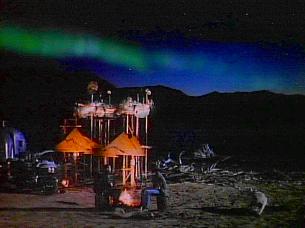 Celestial bodies and happenings are central to a number of episodes of Northern Exposure. In the Season 1 finale (“Aurora Borealis: A Fairytale for Big People”), Chris creates a metal sculpture that represents the northern lights during a restless period in the lunar cycle, when the New Moon is wreaking havoc on everyone’s systems. That the moon would play such a role in the story of a place with so much nighttime darkness should not be surprising. We all know that cultures throughout the world revere the moon in various ways for its powers of regeneration and its link with the hours of slumber. Recent research suggests that the new moon and full moon may actually have a measurable effect on our sleep, but that doesn’t matter. Anecdotal evidence, given freely by village and tribal elders or philosophically-inclined radio DJs alike, is more than proof enough of the power of Luna to influence a person’s habits.
Celestial bodies and happenings are central to a number of episodes of Northern Exposure. In the Season 1 finale (“Aurora Borealis: A Fairytale for Big People”), Chris creates a metal sculpture that represents the northern lights during a restless period in the lunar cycle, when the New Moon is wreaking havoc on everyone’s systems. That the moon would play such a role in the story of a place with so much nighttime darkness should not be surprising. We all know that cultures throughout the world revere the moon in various ways for its powers of regeneration and its link with the hours of slumber. Recent research suggests that the new moon and full moon may actually have a measurable effect on our sleep, but that doesn’t matter. Anecdotal evidence, given freely by village and tribal elders or philosophically-inclined radio DJs alike, is more than proof enough of the power of Luna to influence a person’s habits.
While the events of the Season 1 finale concern the moon, two episodes concern the peculiar effects of the sun on the people of Cicely, at both extreme ends of the solar spectrum. In the Season 4 episode “Midnight Sun”, Joel goes “light loony” as a result of the endless sunlight. Without sleep, dismal Joel becomes suddenly high-octane and coaches the local basketball team to some great victories. The people of Cicely, well-accustomed to the vast fluctuations in light levels throughout the year, are better able to work around the natural inclinations of their climate. In much the same way, in the Season 5 episode “Una Volta in L’Inverno”, the sun’s winter absence from their lives plays with the patterns and emotions of the people in town. Everyone adjusts to the lack of light and vitamin D by absorbing the one hour of pure sunlight they do get by swarming the streets, moths to the proverbial flame; other opt for artificial sunlight, and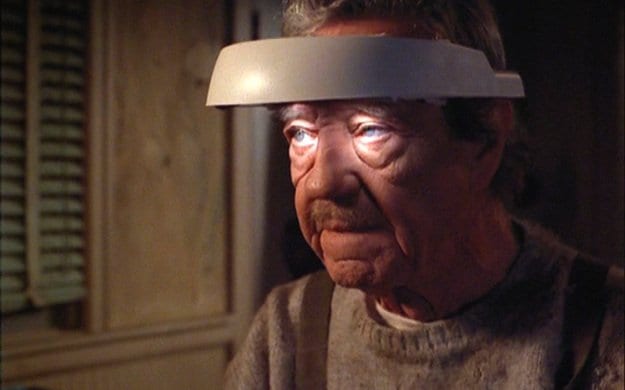 Walt in particular becomes addicted to a special visor that mimics sunshine, which he is using to ward off Seasonal Affective Disorder. This very real disorder affects people around the poles and at higher latitudes and is virtually unknown in other parts of the world where the sunlight supply is constant. The fact that the sun and its superposition in (or disappearance from) the Alaskan sky takes such centre stage in Northern Exposure provides a unique opportunity to showcase the climate but also link it directly to the lives of people who live in such places.
Walt in particular becomes addicted to a special visor that mimics sunshine, which he is using to ward off Seasonal Affective Disorder. This very real disorder affects people around the poles and at higher latitudes and is virtually unknown in other parts of the world where the sunlight supply is constant. The fact that the sun and its superposition in (or disappearance from) the Alaskan sky takes such centre stage in Northern Exposure provides a unique opportunity to showcase the climate but also link it directly to the lives of people who live in such places.
While wintertime may seem like a dark and depressing time for the people of Cicely, these characters take great pains to show us that the opposite is true, and one of the ways that they embrace winter is with lights, whether natural or artificial. The arrival of the aurora borealis took up a prominent place in the Season 1 finale and they make a triumphant return in the Season 5 episode “Mister Sandman”. While beautiful to behold, the mystical northern lights end up switching people’s dreams, causing confusion around town. Maggie has Holling’s dreams (about his abusive French-Canadian father and a traumatic experience he had as a child); Joel has the dreams of a young patient of his (whom he told to lay off the candy); and Ron, one half of a same-sex couple with whom Maurice is constantly at odds because of their sexual orientation, discovers that he is having Maurice’s dreams and that Maurice has a foot fetish. All of this leads to discoveries and affirmations on the parts of these characters. All the while, Chris attempts to reunite the lost dreams with their rightful owners. While I can’t find any independent research to verify the show’s legend about northern lights causing dream switches to occur, it is exactly the kind of mysticism that Northern Exposure dabbles in, and the way that the entire town buys into it is what makes it believable. The aurora may not actually do this in real life, but then again, who knows…?
The Northern Lights also play a role in the Season 3 episode “The Final Frontier”. In contrast to the magic realism of “Mister Sandman“, this episode deals with the very real legend that sexual activity beneath the Northern Lights is made extra potent and that children produced during such an event would be extraordinarily gifted. Droves of Japanese tourists descend upon Cicely in order to experience this phenomenon, leading to an uptick in tourism, which is something that the ever-entrepreneurial Maurice can’t help but notice (though he doesn’t quite get the rewards or accolades he expects).
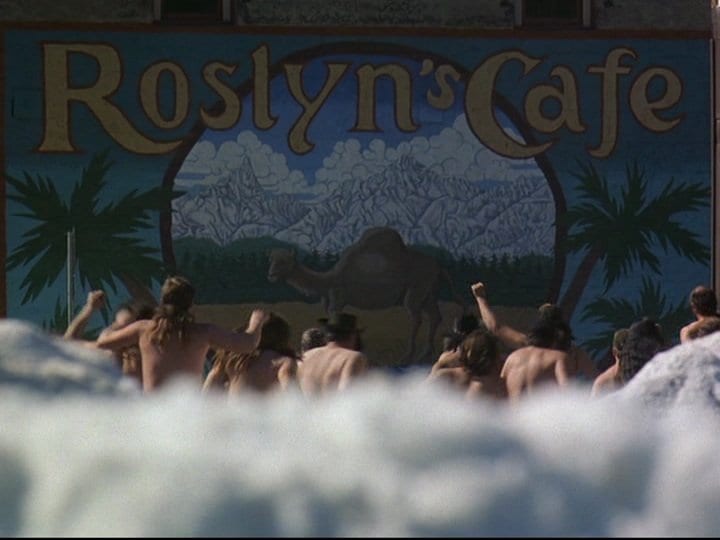 The vernal and autumnal equinoxes, not to be outdone by the more showy solstices, represent times of change, the start of shoulder seasons, when we prepare for the lean times in winter and the verdant times of plenty in summer. Such is the case in the Season 2 episode “Spring Break”, in which the idea of cabin fever is taken to an extreme as the entire town suffers from the effects of the ice breaking on the river. Overcome by craziness, the town sets out to catch a thief (in Ed’s case) or read classic literature (in Shelly’s) or simply to survive their own carnal desires (for Joel and Maggie). In the end, the ice breaks and the dam is flooded, and the men take part in an annual “Running of the Bulls”, a feverish time of another sort, in which the pent up energy of another long, cold, and dark winter are banished in the light of a warm spring sun…on naked bodies, running through the streets of town.
The vernal and autumnal equinoxes, not to be outdone by the more showy solstices, represent times of change, the start of shoulder seasons, when we prepare for the lean times in winter and the verdant times of plenty in summer. Such is the case in the Season 2 episode “Spring Break”, in which the idea of cabin fever is taken to an extreme as the entire town suffers from the effects of the ice breaking on the river. Overcome by craziness, the town sets out to catch a thief (in Ed’s case) or read classic literature (in Shelly’s) or simply to survive their own carnal desires (for Joel and Maggie). In the end, the ice breaks and the dam is flooded, and the men take part in an annual “Running of the Bulls”, a feverish time of another sort, in which the pent up energy of another long, cold, and dark winter are banished in the light of a warm spring sun…on naked bodies, running through the streets of town.
Just as the seasons go through cycles, so too does the body, the individuals in a community, and the community itself. The Season 4 episode “Northern Lights” shows us a little bit of what that looks like, as Ruth-Anne, Holling, and Chris all demonstrate the rituals they undertake before the start of the winter season and the weeks of total darkness ahead. Ruth-Anne paints canvasses full of colour; Holling, digging into his animalistic side, hibernates; and Chris sculpts and designs a beautiful showpiece that is missing the one thing that everyone will miss at this time of year: light.
Watching the ending of this episode this time around reminded me of the emotionally manipulative Tropicana commercial set in the Canadian Arctic, in which an artificial sun lights up the tundra on Day 31 without sunlight. Still, it did make me think: at the end of the day, whether you have 24 hours of sunlight or 24 hours of darkness, what sustains you are the people around you, the relationships you build, the lifelines they represent. Cicely is a place where the adventurous go to find the frontier, their own patch of wilderness, a place where they can always look up at the sky and see something new and glorious. It’s a place of wonder and solitude, but it’s also a place where the weather can be frightful, folk wisdom prevails, and even those most likely to go it alone rely on the help of the guy next door to make it through the thick of winter or the height of summer in one piece…
“Oh the snow the beautiful snow filling the sky and earth below. Over the house tops and over the streets, over the heads of people you meet. Dancing flirting skimming along. Oh the snow the beautiful snow how the flakes gather and laugh as they go. Whirling about in their maddening fun it plays in its glee with everyone. Chasing laughing hurrying by it lights on the face and sparkles the eye. And even the dogs with a bark and a bound snap at the crystals that eddy around. The town is alive and its heart in a glow to welcome the coming of beautiful snow. Bon Hiver Cicely.”
– Chris Stevens
Bon hiver, indeed. Although we’re fast approaching the start of spring and not the first day of winter, Matt and I will be back for the final instalment of this series next Friday with a look at our Top 10 episodes of Northern Exposure. Check back and see if your faves made the cut!.


